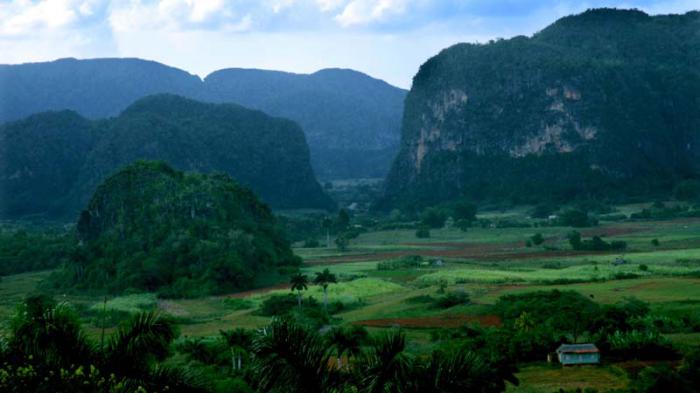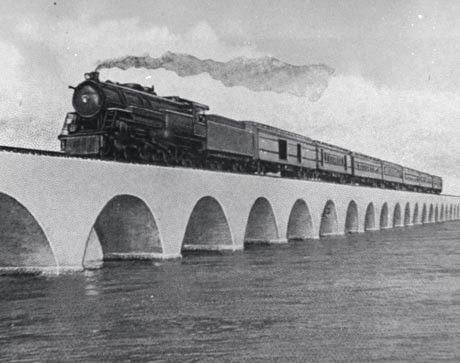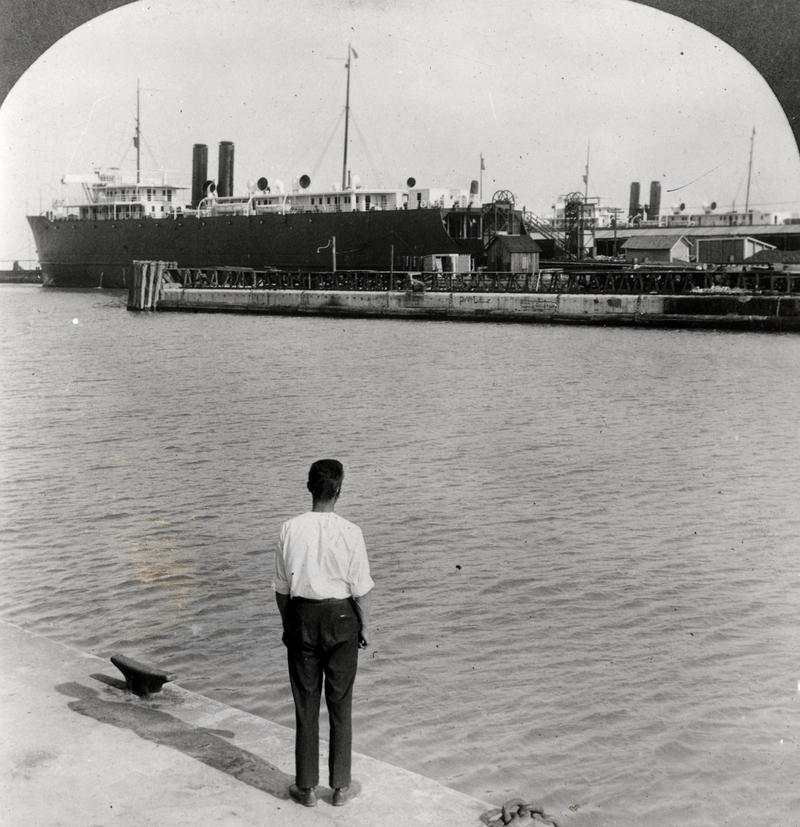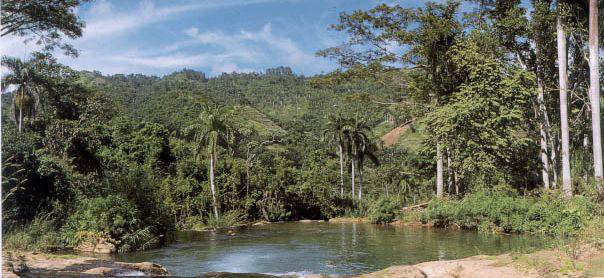In the early twentieth century the most important city in Florida was not Miami, nor San Agustin, nor Pensacola. Orlando, Fort Lauderdale and Jacksonville did not exist yet. The most important city in Florida was Key West, which was essentially a Cuban city with some influence from the United States and the Bahamas.
That is why it was almost a dream the project developed by Henry M. Flagler (January 2, 1830 – May 20, 1913), an American industrialist and founder of Standard Oil. Building his railroad was just the beginning of that dream, he was also a key figure in the development of the Atlantic coast of Florida and founder of what became the Florida East Coast Railway. He is known as the father of Miami, Florida.
With the construction of the railroad to Key West, Florida, Henry Flagler thus completed his dream of extending his railroad all along the Florida peninsula and over the sea to Key West. Many of his contemporaries called that dream a chimera that would never be realized. They called the project “the Chimera of Flagler” but people like Henry Flagler are who make dreams come true.
To persuade Flagler to extend his railroad to Miami, several community owners offered land parcels in exchange for extending their lines to Miami. Julia Tuttle, whom Flagler had met in Cleveland, had a trade at the mouth of the Miami River and was one of the local leaders who contributed land to the effort. There they took the first steps of what would be the beautiful city of Miami, the Capital of the Sun and therefore when the Cubans arrived, they managed to magnify more its beautiful attractions of that tourist world, but let us continue with our history …
These incentives led to the creation of Miami which did not legally exist as a city at that time. The Florida East Coast Railroad arrived in Miami in 1896. Flagler channeled the city, built streets, developed the first municipal electricity and water system. Flagler also financed the city’s first newspaper, The Metropolis.
Continuing with its 1905 expansion policy Flagler decided that his Florida East Coast Railway should extend from Miami to Key West. A distance of 206 kilometers.
At that time, the United States government was engaged in building the Panama Canal and Key West was the deepwater port of the United States closest to the new canal. Flagler wanted to take advantage of receiving channel traffic and increasing trade with Cuba. It should be noted that in 1905 the ties of Key West with Cuba were much stronger than those with the United States, which as we said was a Cuban city with North American and Bahamian influence.
The Miami-Key West railroad increased, as Flagler had assumed, northern tourist traffic to the Florida Keys hotels and trade coming from the Panama Canal but also tremendously developed trade between Cuba and the United States via Key West . The modern and efficient railway system of Cuba of the time was connected by ferry with the Flagler railway in Key West and from there with the United States rail network in the golden era of the railways.
These connections created one of the first intermodal international transport systems in the world and Cuba took advantage of the new logistics to become a major supplier of United States of products that previously could not supply. Cuba developed an important export management of pineapples that left the field and in less than two days they were in New York without leaving their containers.
The flow of passengers between Cuba and the United States increased as one could buy a Santiago de Cuba-New York train ticket and after making the train trip to Havana, took the ferry to Key West and from there by train New York with the same ticket.
The Railroad on the Sea was partially destroyed by the September 1935 hurricane, a category 5 hurricane that has been called by many “cyclone of the century”. On September 2, 1935, the storm killed more than 400 people in the Florida Keys. The railroad yard in Cayo Largo was totally destroyed and a relief train headed for the place was overturned by the swell in Islamorada.
The traffic of passengers and automobiles from Cuba continued after the disappearance of the railroad to Key West until after 1959. Many people came to Miami for a few days with their car from Cuba and I met American families who had his business in Miami and lived in Cuba, traveling every weekend to Cuba to be with his family.
They say that other times were better … I think so.
EL NEGOCIO FERROVIARIO ENTRE CUBA Y ESTADOS UNIDOS. EL SUEÑO DE HENRY FLAGLER.
A principios del siglo XX la ciudad más importante de Florida no era Miami, ni San Agustín, ni Pensacola. Orlando, Fort Lauderdale y Jacksonville no existían aún. La ciudad más importante de la Florida era Cayo Hueso, que era esencialmente una ciudad cubana con alguna influencia de Estados Unidos y las Bahamas.
Por eso fue casi un sueño proyecto desarrollado por Henry M. Flagler (2 de enero de 1830 – 20 de mayo de 1913), un industrial estadounidense y fundador de Standard Oil. La construcción de su ferrocarril fue sólo el comienzo de ese sueño, también fue una figura clave en el desarrollo de la costa atlántica de la Florida y fundador de lo que se convirtió en la Florida East Coast Railway. Es conocido como el padre Miami, Florida.
COn la construccion del ferrocarril hasta Cayo Hueso, Florida Henry Flagler culminaba así su sueño de extender su ferrocarril a todo lo largo de la península de La Florida y sobre el mar hasta Cayo Hueso. Muchos de sus contemporáneos calificaron ese sueño de una quimera que nunca sería realizado. Llamaban al proyecto “la quimera de Flagler” pero personas como Henry Flagler son quienes convierten los sueños en realidad.
Para convencer a Flagler de que extendiera su ferrocarril a Miami, varios propietarios de la comunidad le ofrecieron parcelas de tierra a cambio de que extendiera sus líneas hasta Miami. Julia Tuttle, a quien Flagler había conocido en Cleveland tenía un comercio en la boca del río Miami y fue una de los líderes locales que aportaron tierra para el empeño. Alli comoenzaron los primeros pasos de lo que seria la bella ciudad de Miami, la Capital del Sol y por ende al llegar los cubanos a ella lograron engrandecer mas sus bellos atractivos de ciudad ese mundo turistico, pero continuemos con nuestra historia…
Esos incentivos llevaron a la creación de Miami la cual no existía legalmente como ciudad en esa época. El Florida East Coast Railroad llegó a Miami en 1896. Flagler canalizó la ciudad, construyó calles, desarrolló el primer sistema municipal de electricidad y agua. Flagler financió además el primer periódico de la ciudad, The Metropolis.
Siguiendo con su política de expansión 1905 Flagler decidió que su Florida East Coast Railway debía extenderse desde Miami a Cayo Hueso. Una distancia de 206 kilómetros.
En aquella época, el gobierno de Estados Unidos estaba enfrascado en construir el Canal de Panamá y Cayo Hueso era el puerto de aguas profundas de Estados Unidos más cercano al nuevo canal. Flagler quería aprovechar las ventajas de recibir el tráfico del canal y aumentar el comercio con Cuba. Hay que destacar que en 1905 los lazos de Cayo Hueso con Cuba eran mucho más fuertes que los que tenía con Estados Unidos, que como dijimos era una ciudad cubana con influencia norteamericana y bahamesa.
El ferrocarril Miami-Cayo Hueso incrementó, como Flagler había supuesto, el tráfico de turistas del norte hacia los hoteles de los cayos de Florida y el comercio que venía del Canal de Panamá pero además desarrolló tremendamente el comercio entre Cuba y Estados Unidos vía Cayo Hueso. El moderno y eficiente sistema ferroviario de Cuba de la época se conectaba vía trasbordador con el ferrocarril de Flagler en Cayo Hueso y de ahí con la red ferroviaria de Estados Unidos en la era de oro de los ferrocarriles.
Estas conexiones crearon uno de los primeros sistemas internacionales intermodal de transporte en el mundo y Cuba aprovechó la nueva logística para convertirse en un suplidor importante de Estados Unidos de productos que anteriormente no le era posible suministrar. Cuba desarrolló una importante gestión de la exportación de piñas que salían del campo y en menos de dos días estaban en Nueva York sin salir de sus contenedores.
El flujo de pasajeros entre Cuba y Estados Unidos se incrementó ya que uno podía comprar un billete de tren Santiago de Cuba-Nueva York y después de hacer el viaje en tren hasta La Habana, tomaba el trasbordador a Cayo Hueso y de ahí en tren hasta Nueva York con el mismo billete.
El Ferrocarril sobre el Mar fue parcialmente destruido por el ciclón de septiembre de 1935, un huracán con categoría 5 que ha sido llamado por muchos “el ciclón del siglo”. En septiembre 2 de 1935 la tormenta mató a más de 400 personas en los cayos de Florida. El patio del ferrocarril en Cayo Largo fue totalmente destruido y un tren de auxilio que se dirigía al lugar fue volcado por la marejada en Islamorada.
El tráfico de pasajeros y automóviles desde Cuba siguió después de la desaparición del ferrocarril a Cayo Hueso hasta después de 1959. Muchas personas venían a Miami por unos días con su automóvil desde Cuba y conocí familias norteamericanas que tenían sus negocios en Miami y vivían en Cuba, viajando cada fin de semana a Cuba para estar con su familia.
Dicen que otros tiempos fueron mejor… así lo creo.
Agencies/MemoriasCubanas/Carlos Rodríguez/Wiki/Internet Photos/ Arnoldo Varona/ TheCubanHistory.com
THE CUBAN HISTORY, HOLLYWOOD.










